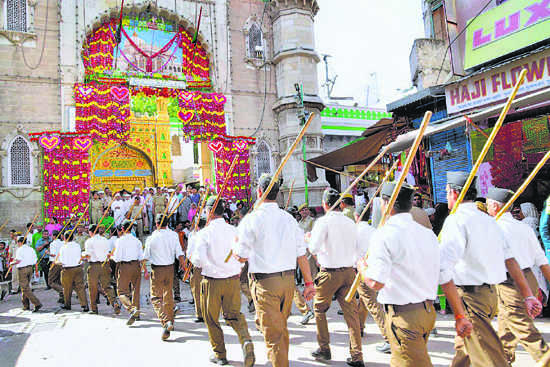Parivar in Communist clothes
HAVING lived in Moscow for nearly two years in the dying days of the Soviet Union, the strains of marrying ideology with strident nationalism being practised by the ruling dispensation in India are becoming apparent every day. Every regime of the left or right, aspiring for absolute power, shares common characteristics.
And the mayor of Jaipur, Mr Ashok Lahoty, of the BJP-ruled Rajasthan, has provided a perfect case study of the party and the larger Sangh Parivar presided over by the RSS. He starts with the famous Communist theme song, if you are not with us, you are with the enemy.
This admonition was given to those who opposed starting their municipal duties in the morning with the national anthem and ending their working day with Vande Mataram. His advice was that such dissenters should go to Pakistan, despite the Supreme Court’s recent comment that patriotism should not be worn on the sleeve.
Mr Lahoty’s reasoning is instructive, recalling the Communist jargon of another era. According to the written notice, the decision was taken to inculcate “a sense of patriotism and love for the country”, “maintain discipline” and ensure “a positive work environment”. The inspiration of playing the national anthem came to Mr Lahoty because “apart from patriotism and love for country, it will develop work culture ensuring that everyone goes to work with positive energy. It will increase ‘collectivity’ and discipline. Another aim is to make people come on time”.
The old Soviet ideal was the creation of “the new man”. The Sangh Parivar’s ideal is the transformation of the Indian nourished on a diet of the Independence movement led by giants and the inspirational leadership of Jawaharlal Nehru and his secular creed. The RSS ideal is still being formulated but its essence is a narrow form of nationalism and belief in a cornucopia of myths of Hindu superiority in a doctored history dominated by a desire to show Muslims, kings and commoners alike, in a bad light.
It is not only Mr Lahoty who has fallen prey to the charms of the now- largely defunct Communist methods of governance, but also the RSS’s penchant for issuing diktats on how private individuals should live, eat and work. The aim, of course, is to achieve Hindu rashtra in the shortest possible period of time.
Beef is taboo in view of the veneration the cow as a symbol enjoys for the bulk of the country’s citizens. But there are edicts on what women in particular should wear. Finally, it has been decided to avoid the unbecoming spectacle of venerable men with protruding stomachs march in khaki shorts for the morning drill by decreeing trousers. Congress vice-president Rahul Gandhi recently asked why women were ostracised from the morning drill. Was it because they would have to wear shorts?
Underlying Mr Gandhi’s jibe was the conservative patriotic blend of a male-dominated concept of the RSS leadership, with women’s role being largely in the home or, at best, aides to a male leader. What is new is the decision of the Congress establishment to hit back at the government, instead of swallowing insults from the master of aphorisms, PM Narendra Modi.
BJP-ruled states have been given a measure of freedom in determining the speed at which the Hindu rashtra has to be brought about. Rajasthan seems most eager to stand up and be counted. A measure protecting civil servants from being prosecuted for misdemeanours has had to be pigeonholed in a select committee, given the general outcry against it. But the state CM, Ms Gayatri Devi, herself of princely lineage, is determined to be the first among the flag-bearers of the Hindu rashtra.
Beating the drum of nationalism is one thing but despite the techniques the Sangh Parivar has copied from Communist practice, it sings to its own tune. And that tune, explained in many ways, is the veneration of ancient India with all the myths ascribed to it, the conversion of a secular country into a Hindu state, with minorities living on the sufferance of the majority.
India still has a secular Constitution but the BJP’s hope is that relatively soon it will gain sufficient strength in the two Houses of Parliament to convert it into Hindu rashtra. Indeed, it was strange to hear from Mr Modi recently in launching the “unity run” in New Delhi to talk about diversity in unity. His theme song thus far has been the glories of ancient (Hindu) India and the miracles it had enacted.
A problem with contemplating a change of this order is to keep followers under control. They are, after all, the first to swallow their own party’s propaganda. Thus we have a BJP MP from UP denigrating the Taj Mahal as a blot on Indian culture. And any number of Sangh Parivar men and women just want to get on with the job of bringing Hindu rashtra into being tomorrow.
For any leader of whatever ilk, the task of governing a country as diverse as India with a population of Muslims running into millions on a pronounced anti-Muslim bias is a formidable one. Thus far state and Central legislators have fallen prey to overreaching themselves, often leading to inter-communal riots and deaths. More often than not, the Central leadership remains silent and there is the unexpressed feeling that this is an RSS problem.
In the country’s relations with the outside Muslim world in particular, we are running perilously close to the danger mark. We have taken care to keep relations on an even keel with important countries such as Saudi Arabia, the UAE and Iran in the Middle East because they are our major economic partners. The question that will inevitably arise is at what stage India’s domestic policies towards minorities will invite a backlash from the Muslim world.
It would help if the authorities were to define in precise terms the new Indian of their conception. Is Yogi Adityanath the ideal?










